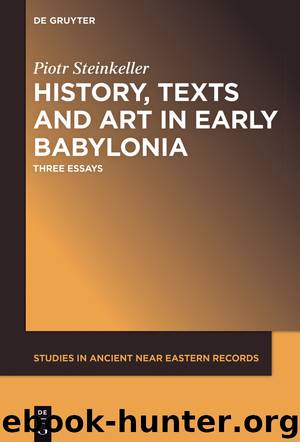History, Texts and Art in Early Babylonia by Piotr Steinkeller

Author:Piotr Steinkeller
Language: eng
Format: epub
Publisher: Walter de Gruyter
Published: 2017-05-25T16:00:00+00:00
Essay 3
Mythical Realities of the Early Babylonian History (or the Modern Historian and the Native Uses of History Past)
The real is as imagined as the imaginary.
Clifford Geertz
1 This essay reviews current approaches to the study of third millennium history, in particular, the recent debate over the appropriateness of using the so-called “historical-literary” texts and the sources of a transparently mythological character as a means of “filling in the lacunae” in the political history of early Babylonia as it can be reconstructed from the contemporary “historical” records. Having concluded that all such sources – including the records presumed to be authentically “historical” – are mythical in nature, it will be argued that, while these sources are of doubtful value for the program of an histoire événementielle, they will – if approached on their own terms – tell us a great deal about the social and political matrix of early Babylonia, through their vision of history as a symbolic or mythical reality.
2 Much of the current debate in historiography has been concerned with the place of narrative in historical writing. Should the history of events, which will always be marred by the original sin of subjectivity, be abandoned in favor of the history of structures? Or, since the structures so created turn out to be narratives themselves, should one assume that all historical writing is unavoidably and fatally a narrative, and try simply to develop new and better types of narratives, such as, for example, the Geertzian “thick description”?
If the preoccupation with such questions is the badge that lends one the right to call himself a historian, few of the historically-minded Assyriologists will meet this definition, since most of them toil without the benefit of having at their disposal even the most basic and rudimentary narrative histories of particular periods. However simplistic, naive, and unattainable the Rankean goal of “discovering what really happened” may seem to the modern historian, to us Assyriologists it is still a real and a fully rational objective.
My own interests focus on third millennium Babylonia, and therefore this essay is concerned with that particular phase of Mesopotamian history. In practical terms, this means only the period between 2400 and 2000 BC, since no narrative information of any real consequence is available from the earlier centuries. Here I hasten to note that the following observations derive nearly entirely from the study of third millennium data.451 Because of this, in no way are they meant to serve as a characterization of all the historical sources stemming from ancient Mesopotamia, in particular those dating to the first millennium BC. I should also stress that this essay is concerned exclusively with the issues of political history. Clearly, in other areas of the historical research into early Babylonia, such as, for example, socio-economic studies, the situation is considerably different, both in terms of what is textually available and of what can be done with this evidence for the purposes of scientific analysis.
The starting point of this essay is the following question: are we
Download
This site does not store any files on its server. We only index and link to content provided by other sites. Please contact the content providers to delete copyright contents if any and email us, we'll remove relevant links or contents immediately.
The Five People You Meet in Heaven by Mitch Albom(3334)
Real Sex by Lauren F. Winner(2861)
Name Book, The: Over 10,000 Names--Their Meanings, Origins, and Spiritual Significance by Astoria Dorothy(2836)
The Holy Spirit by Billy Graham(2775)
The Secret Power of Speaking God's Word by Joyce Meyer(2748)
ESV Study Bible by Crossway(2665)
How The Mind Works by Steven Pinker(2611)
0041152001443424520 .pdf by Unknown(2592)
Ancient Worlds by Michael Scott(2492)
The ESV Study Bible by Crossway Bibles(2410)
The Gnostic Gospels by Pagels Elaine(2392)
The Meaning of the Library by unknow(2385)
Churchill by Paul Johnson(2360)
MOSES THE EGYPTIAN by Jan Assmann(2275)
Jesus by Paul Johnson(2223)
City of Stairs by Robert Jackson Bennett(2222)
The Complete Dead Sea Scrolls in English (7th Edition) (Penguin Classics) by Geza Vermes(2135)
Ancient Near Eastern Thought and the Old Testament by John H. Walton(2129)
The Nativity by Geza Vermes(2110)
